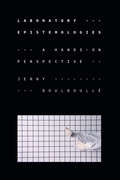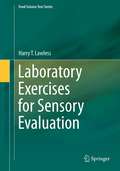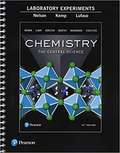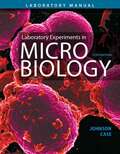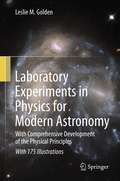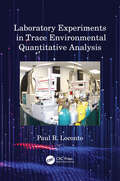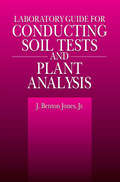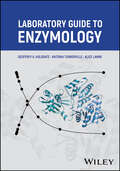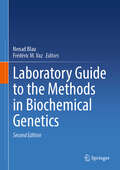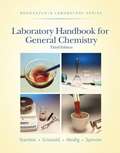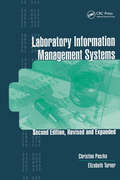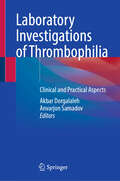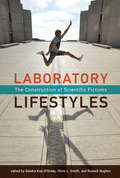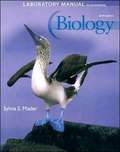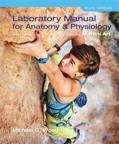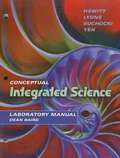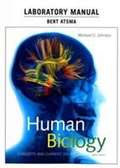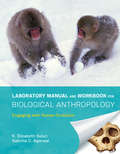- Table View
- List View
Laboratory Control System Operations in a GMP Environment
by David M. BliesnerDevelop an understanding of FDA and global regulatory agency requirements for Laboratory Control System (LCS) operations In Laboratory Control System Operations in a GMP Environment, readers are given the guidance they need to implement a CGMP compliant Laboratory Control System (LCS) that fits within Global Regulatory guidelines. Using the Quality Systems Approach, regulatory agencies like the FDA and the European Medicine Agency have developed a scheme of systems for auditing pharmaceutical manufacturing facilities which includes evaluating the LCS. In this guide, readers learn the fundamental rules for operating a CGMP compliant Laboratory Control System. Designed to help leaders meet regulatory standards and operate more efficiently, the text includes chapters that cover Laboratory Equipment Qualification and Calibration, Laboratory Facilities, Method Validation and Method Transfer, Laboratory Computer Systems, Laboratory Investigations as well as Data Governance and Data Integrity. The text also includes chapters related to Laboratory Managerial and Administrative Systems, Laboratory Documentation Practices and Standard Operating Procedures and General Laboratory Compliance Practices. Additionally, a chapter outlining Stability Program operations is included in the text. In addition to these topics, it includes LCS information and tools such as: ● End of chapter templates, checklists, and LCS guidance to help you follow the required standards ● Electronic versions of each tool so users can use them outside of the text ● An In-depth understanding of what is required by the FDA and other globally significant regulatory authorities for GMP compliant systems For quality assurance professionals working within the pharmaceutical or biopharma industries, this text provides the insight and tools necessary to implement government-defined regulations.
Laboratory Design Handbook
by E. Crawley CooperLaboratory Design Handbook describes the process, motivation, constraints, challenges, opportunities, and specific design data related to the creation of a modern research laboratory. The information presented is based on a large pool of experience in the development of new and renovated laboratory buildings for universities, teaching hospitals, ph
Laboratory Epistemologies: A Hands-On Perspective (Experimental Futures)
by Jenny BoulboulléIn Laboratory Epistemologies: A Hands-On Perspective, Jenny Boulboullé examines the significance of hands-on experiences in contemporary life sciences laboratories. Addressing the relationship between contemplation and manipulation in epistemology, Boulboullé combines participant observations in molecular genetics labs and microbiological cleanrooms with a longue durée study of the history and philosophy of science. She radically rereads Descartes’s key epistemological text Meditations on First Philosophy, reframing the philosopher as a hands-on knowledge maker. With this reading, Boulboullé subverts the pervasive modern conception of the disembodied knower and puts the hands-on experimenter at the heart of life sciences research. In so doing, she contributes a theoretical model for understanding how life processes on cellular and molecular levels are manually produced in today’s techno-scientific spaces. By reassessing the Cartesian legacy and arguing that epistemology should be grounded in the standpoint of a hands-on practitioner, Boulboullé offers the philosophical and historical foundation to understand and study contemporary life sciences research as multisensory embodied practices.
Laboratory Exercises for Sensory Evaluation
by Harry T. LawlessLaboratory exercises are a necessary part of science education. They enable students to better understand the principles discussed in lectures, and provide them with hands-on experience of the practical aspects of scientific research. The purpose of this book is to provide students and instructors with a time-tested set of lab exercises that illustrate the common sensory tests and/or sensory principles used in evaluation of foods, beverages and consumer products. The appendices will also include a set of simple problem sets that can be used to teach and reinforce basic statistical tests. Approximately twenty years ago the Sensory Evaluation Division of the Institute of Food Technologists sponsored the preparation of a set of exercises titled "Guidelines for Laboratory Exercises for a Course in Sensory Evaluation of Foods," edited by one of the co-authors (Heymann). This book will provide additional materials from the second author (Lawless), as well as other instructors, in a uniform format that can be easily adopted for course use. Most importantly, the lab exercises will complement the flagship textbook in the field, Sensory Evaluation of Foods: Principles and Practices, 2E, also by Lawless and Heymann and published by Springer. Possible course adoption of the main text along with the lab manual should enhance the sales of these materials.
Laboratory Experiments Chemistry: The Central Science
by John H. Nelson Kenneth C. Kemp Michael LufasoThis manual contains 43 finely tuned experiments chosen to introduce basic lab techniques and to illustrate core chemical principles. In the 14th Edition, all experiments were carefully edited for accuracy, safety, and cost. Pre-labs and questions were revised and new experiments added concerning solutions, polymers, and hydrates. Each of the experiments is self-contained, with sufficient background material, to conduct and understand the experiment. Each has a pedagogical objective to exemplify one or more specific principles. <P><P> Because the experiments are self-contained, they may be undertaken in any order, although the authors have found in their General Chemistry course that the sequence of Experiments 1 through 7 provides the firmest background and introduction. The authors have included pre-lab questions to answer before starting the lab. The questions are designed to help in understanding the experiment, learning how to do the necessary calculations to treat their data, and as an incentive for reading the experiment in advance. These labs can also be customized through Pearson Collections, our custom database program.
Laboratory Experiments Using Microwave Heating
by Nicholas E. Leadbeater Cynthia B. McGowanAllowing many chemical reactions to be completed within minutes, microwave heating has revolutionized preparative chemistry. As a result, this technology has been widely adopted in both academic and industrial laboratories. Integrating microwave-assisted chemistry into undergraduate laboratory courses enables students to perform a broader range of
Laboratory Experiments in Microbiology (What's New in Microbiology)
by Ted Johnson Christine CaseFor general microbiology laboratory courses Laboratory Experiments in Microbiology features 57 thoroughly class-tested and easily customizable exercises that teach basic microbiology techniques and applications. The manual provides comprehensive coverage of every area of microbiology across diverse disciplines, including the biological sciences, allied health sciences, agriculture, environmental science, nutrition, pharmacy, and various pre-professional programs. The lab manual is the perfect companion to Tortora/Funke/Case’s Microbiology: An Introduction, 13th Edition or any introductory microbiology text. The 12th Edition of Laboratory Experiments in Microbiology is easier than ever to navigate and more visually effective with new icons indicating when an exercise addresses the human or environmental microbiome, is investigative, or addresses an ASM guideline. New ASM Thinking Skills outline the steps that help develop laboratory thinking skills. Pre-lab quizzes in MasteringTM Microbiology ensure students arrive prepared for each lab, and activities such as Lab and Lecture: Putting It All Together help students see how lab and lecture are integrated.
Laboratory Experiments in Physics for Modern Astronomy
by Leslie M. GoldenThis book presents experiments which will teach physics relevant to astronomy. The astronomer, as instructor, frequently faces this need when his college or university has no astronomy department and any astronomy course is taught in the physics department. The physicist, as instructor, will find this intellectually appealing when faced with teaching an introductory astronomy course. From these experiments, the student will acquire important analytical tools, learn physics appropriate to astronomy, and experience instrument calibration and the direct gathering and analysis of data. Experiments that can be performed in one laboratory session as well as semester-long observation projects are included.
Laboratory Experiments in Trace Environmental Quantitative Analysis
by Paul R. LocontoLaboratory Experiments in Trace Environmental Quantitative Analysis is a collection of student-tested experiments that introduce important principles that underlie various laboratory techniques in the field of trace environmental organics and inorganics quantitative analysis. It crosses the more traditional academic disciplines of environmental science and analytical chemistry. The text is organized to begin with minimally rigorous session/experiments and increase in rigor as each session/experiment unfolds. Each experiment features learning objectives, expected student outcomes, and suggestions for further study. Additional features include: Students are introduced to the principles and laboratory practice of instrumental analysis (determinative techniques) that are clearly presented. Students are carefully taken through various ways to prepare samples for trace quantitative analysis (sample prep techniques). Safety warnings are listed within each experiment. Students are introduced to all three types of instrument calibration: external, internal and standard addition. Instructors who are responsible for laboratory courses in analytical chemistry with potential application to environmental sample matrices will find this textbook of value. Graduate programs in environmental science and engineering will also greatly benefit from the content.
Laboratory Fundamentals of Microbiology (Eleventh Edition)
by Jeffrey C. PommervilleLaboratory Fundamentals of Microbiology
Laboratory Guide for Conducting Soil Tests and Plant Analysis
by Jr., J. JonesWith the help of this guide, you can use obtained test results to evaluate the fertility status of soils and the nutrient element status of plants for crop production purposes. It serves as an instructional manual on the techniques used to perform chemical and physical characteristic tests on soils. Laboratory Guide for Conducting Soil Tests and Pl
Laboratory Guide to Enzymology
by Geoffrey A. Holdgate Antonia Turberville Alice LanneLABORATORY GUIDE TO ENZYMOLOGY An accessible guide to understanding the foundations of enzymology at its application in drug discovery Enzymes are highly specialized proteins necessary for performing specific biochemical reactions essential for life in all organisms. In disease, the functioning of these enzymes can become altered and, therefore, enzymes represent a large class of key targets for drug discovery. In order to successfully target dysfunctional enzymes pharmaceutically, the unique mechanism of each enzyme must be understood through thorough and in-depth kinetic analysis. The topic of enzymology can appear challenging due its interdisciplinary nature combining concepts from biology, chemistry, and mathematics. Laboratory Guide to Enzymology brings together the theory of enzymology and associated lab-based work to offer a practical, accessible guide encompassing all three scientific disciplines. Beginning with a brief introduction to proteins and enzymes, the book slowly immerses the reader into the foundations of enzymology and how it can be used in drug discovery using modern methods of experimentation. The result is a detailed but highly readable volume detailing the basis of drug discovery research. Laboratory Guide to Enzymology readers will also find: Descriptions of key concepts in enzymology Examples of drugs targeting different enzymes via different mechanisms Detailed discussion about many areas of enzymology such as binding and steady-state kinetics, assay development, and enzyme inhibition and activation Laboratory Guide to Enzymology is ideal for all pharmaceutical and biomedical researchers working in enzymology and assay development, as well as advanced students in the biochemical or biomedical sciences looking to develop a working knowledge of this field of research.
Laboratory Guide to Human Physiology: Concepts and Clinical Applications
by Stuart Ira FoxThe seventh edition of this laboratory guide, like the previous editions, is a "stand-alone" human physiology manual that can be used in conjunction with any human physiology textbook. It includes a wide variety of exercises that support most areas covered in a human physiology course, thus affording instructors the flexibility to choose those exercises best suited to meet their particular instructional goals. Background information that is needed to understand the principles and significance of each exercise is presented in a concise manner, so that little or no support is needed from the lecture text. <p><p> The lecture and laboratory segments of the human physiology course, however, are most effectively wedded when they cover topics in a similar manner and sequence. Thus, this laboratory guide is best used in conjunction with my textbook, Human Physiology, fifth edition (Wm. C. Brown Publishers, 1996). <p> The laboratory experiences provided by this guide allow students to become familiar--in an intimate way that cannot be achieved by lecture and text alone--with many fundamental concepts of physiology. In addition to providing hands-on experience in applying physiological concepts, the laboratory sessions allow students to interact with the subject matter, other students, and the instructor in a personal, less formal way. Active learning is required to perform the exercises and to complete the laboratory report at the end of each exercise.
Laboratory Guide to the Methods in Biochemical Genetics
by Nenad Blau Frédéric M. VazNow in its 2nd edition, this manual describes laboratory methodology for the diagnosis of inherited metabolic diseases. The book describes a spectrum of tests, from simple screening methods via classical methods that are operational in most (if not all) biochemical laboratories, to analytical methods that depend on technologies that very few are currently employing in their labs, but are certainly the functional techniques in a biochemical laboratory in this post-genomics era. Each chapter is sufficiently detailed to be self-contained, thus enabling laboratory specialists to adopt the method in their own laboratory and obviating the need for additional methods or references. The second updated edition of the book is unique in that it is the first of its kind to be published in the last 13 years, and individual chapters have been developed by experts in the field citing both established and cutting-edge (omics) technology. Thus, it is an indispensable resource for researchers and clinicians working on the field of inherited metabolic diseases and those interested in laboratory diagnoses.
Laboratory Handbook for General Chemistry (Third Edition)
by Conrad L. Stanitski Norman E. Griswold H. A. Neidig James N. SpencerThis book is a "how to" guide containing specific information about the basic equipment, techniques, and operations that you will use in your laboratory experiments.
Laboratory Information Management Systems
by Elizabeth Turner Christine PaszkoDetails the most recent advances in Laboratory Information Management Systems. Offers contemporary approaches to system development, design, and installation; system customization; software and hardware compatibility; quality assurance and regulatory requirements; and resource utilization.
Laboratory Investigations
by PearsonLaboratory Investigations for Biology 112 Third Custom Edition for Clackamas Community College
Laboratory Investigations for AP Environmental Science (Second Edition)
by William MolnarLaboratory Investigations for AP Environmental Science (Second Edition) by William Molnar
Laboratory Investigations of Thrombophilia: Clinical and Practical Aspects
by Akbar Dorgalaleh Anvarjon SamadovThis comprehensive book offers an in-depth overview of laboratory diagnoses for both inherited and acquired thrombophilias, illuminating the complex interplay between genetic and environmental factors that contribute to venous thromboembolism. Beginning with foundational concepts in thrombophilia testing, the book systematically covers the diagnosis of key anticoagulant deficiencies, including protein C, protein S, protein Z, antithrombin, and plasminogen, as well as the critical evaluation of prothrombin G20210A and factor V Leiden mutations and other factors involved in thrombosis. It also addresses acquired thrombophilia, highlighting the significant impact of factors such as hyperhomocysteinemia and the influence of medications, lifestyle choices, and underlying health conditions on thrombosis risk. Each chapter clarifies the principles behind various laboratory assays, detailing the preanalytical variables that can affect results and guiding the interpretation of findings. Real-world challenges in thrombophilia testing such as during pregnancy, the use of oral contraceptives, and monitoring anticoagulation therapy are specifically examined. Written in a clear yet comprehensive style, this book is aimed at thrombosis specialists, hematologists, laboratory scientists, and students. It provides extensive knowledge, practical guidance, and evidence-based protocols for thrombophilia testing, ensuring accurate diagnosis and effective management of this life-threatening disorder.
Laboratory Lifestyles: The Construction of Scientific Fictions (Leonardo)
by Chris Smith Russell Hughes Sandra Kaji-O'GradyA generously illustrated examination of the boom in luxurious, resort-style scientific laboratories and how this affects scientists' work. The past decade has seen an extraordinary laboratory-building boom. This new crop of laboratories features spectacular architecture and resort-like amenities. The buildings sprawl luxuriously on verdant campuses or sit sleekly in expensive urban neighborhoods. Designed to attract venture capital, generous philanthropy, and star scientists, these laboratories are meant to create the ideal conditions for scientific discovery. Yet there is little empirical evidence that shows if they do. Laboratory Lifestyles examines this new species of scientific laboratory from architectural, economic, social, and scientific perspectives. Generously illustrated with photographs of laboratories and scientists at work in them, the book investigates how “lifestyle science” affects actual science. Are scientists working when they stretch in a yoga class, play volleyball in the company tournament, chat in an on-site café, or show off their facilities to visiting pharmaceutical executives?The book describes, among other things, the role of beanbag chairs in the construction of science at Xerox PARC; the Southern California vibe of the RAND Corporation (Malibu), General Atomic (La Jolla), and Hughes Research Laboratories (Malibu); and Biosphere 2's “bionauts” as both scientists and scientific subjects; and interstellar laboratories. Laboratory Lifestyles (the title is an allusion to Bruno Latour and Steve Woolgar's influential Laboratory Life) documents a shift in what constitutes scientific practice; these laboratories and their lifestyles are as experimental as the science they cultivate. Contributors Kathleen Brandt, Russell Hughes, Tim Ivison, Sandra Kaji-O'Grady, Stuart W. Leslie, Brian Lonsway, Sean O'Halloran, Simon Sadler, Chris L. Smith, Nicole Sully, Ksenia Tatarchenko, William Taylor, Julia Tcharfas, Albena Yaneva, Stelios Zavos
Laboratory Manual Biology
by Sylvia S. MaderThe Biology Laboratory Manual, Tenth Edition, is written by Dr. Sylvia Mader. With few exceptions, each chapter in the text has an accompanying laboratory exercise in the manual. Every laboratory has been written to help students learn the fundamental concepts of biology and the specific content of the chapter to which the lab relates, and to gain a better understanding of the scientific method.
Laboratory Manual For Anatomy And Physiology Featuring Martini Art, Main Version
by Michael WoodThis laboratory manual is designed to serve the lab course that accompanies the two-semester anatomy and physiology lecture course. It provides students with comprehensive coverage of anatomy and physiology, beautiful full-color art and photographs, and an intuitive pedagogical framework. The primary goals of this manual are to provide students with hands-on experiences that reinforce the information they learn in the lecture course and to help them understand three-dimensional relationships, visualize complex structures, and comprehend intricate physiological processes. The manual is written to correspond to all current two-semester anatomy and physiology textbooks, although those students and instructors using Fundamentals of Anatomy & Physiology, Tenth Edition, by Frederic H. Martini, Judi L. Nath, and Edwin F. Bartholomew will recognize here some of the superb art from that text by William Ober and Claire Garrison, Martini's renowned biomedical illustrators. This sixth edition manual is available in three separate versions. The Main Version covers the full two-semester A&P curriculum, including dissections of the cow eye and of the sheep heart, brain, and kidney. The Cat Version includes all of the same material plus an additional section of nine cat dissection exercises encompassing the major body systems. The Pig Version, similarly, includes all of the material from the Main Version with a separate section of nine fetal pig dissection exercises. The Cat and Pig Versions make the manual more useful to instructors whose students perform animal dissections in the lab. The outstanding dissections and accompanying photographs are by Shawn Miller and Mark Neilsen and I thank each of them for their expertise.
Laboratory Manual For Conceptual Integrated Science
by Paul G. Hewitt John A. Suchocki Jennifer Yeh Suzanne A. LyonsThis guide provides a variety of hands-on activities and experiments that complement the Active Explorations throughout the text.
Laboratory Manual For Human Biology: Concepts And Current Issues
by Michael D. Johnson Bert AtsmaThe Laboratory Manual provides an emphasis on critical thinking and includes Safety Guidelines, Objectives, A List of Materials Needed, Topic Introduction, Activities with embedded questions, and Critical Thinking Questions.
Laboratory Manual and Workbook for Biological Anthropology
by Sabrina C. Agarwal K. Elizabeth SoluriThe perfect lab solution. A vividly illustrated, flexible, and topically balanced manual with a critical-thinking approach


